Types of Algae and Their Benefits

alvarez / Getty Images
Medically reviewed by Jamie Johnson, RDNMedically reviewed by Jamie Johnson, RDN
Algae is a fascinating and highly beneficial group of aquatic organisms making waves in the wellness and nutrition market. Algae, also sometimes referred to as seaweed, is responsible for more than just the green color of oceans and lakes: it's a powerhouse of nutrients, including vitamins, minerals, and proteins.
For those following a vegan lifestyle or who avoid fish, algae can be a source of DHA omega-3 fatty acid, a nutrient that supports eye, brain, and heart health. With its ability to potentially support many aspects of your health, including heart health, immunity, and aid in weight management, algae are rapidly gaining popularity among health-conscious individuals seeking natural ways to enhance their well-being.
Whether it's spirulina or chlorella making its way into smoothies or skincare routines, algae is a versatile and beneficial addition to your daily wellness routine. Here are five of the healthiest types of algae for you.
1. Spirulina
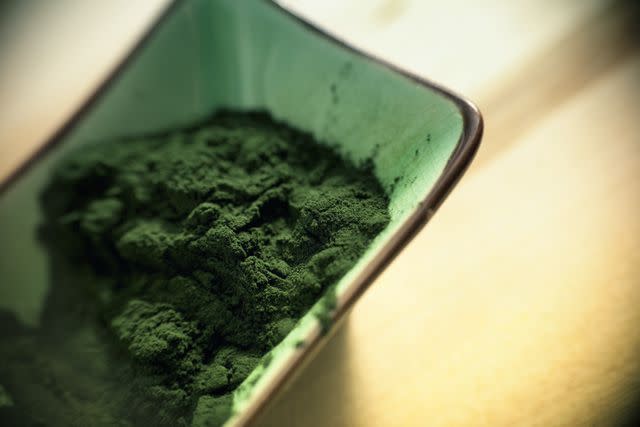
tjasam / Getty Images
Spirulina is a biomass of cyanobacteria (blue-green algae) that can be consumed by people and animals. It is renowned for its intense green color and has been utilized as a dietary supplement due to its protein content (one tablespoon provides 4 grams (g) of protein) and its rich supply of vitamins, minerals, and antioxidants. Spirulina thrives in fresh and saltwater environments and has been a part of human diets for centuries, notably among ancient civilizations in Central America and Africa.
Spirulina's high antioxidant content makes it beneficial in protecting against oxidative damage. It may support normal brain functions and the development of the nervous system. Preliminary clinical studies suggest supplementing with spirulina can protect brain health by enhancing brain development and motor and language skills, especially in malnourished children. Spirulina has also been shown to improve mental and physical fatigue.
Spirulina might also improve blood glucose, lipids, and blood pressure levels, but additional clinical studies are needed.
Spirulina can be integrated into one's diet in several ways. It is available in powder form, which can be added to smoothies, juices, or even sprinkled over salads. Tablets and capsules are also available for those who prefer a more convenient consumption method.
2. Sea Moss
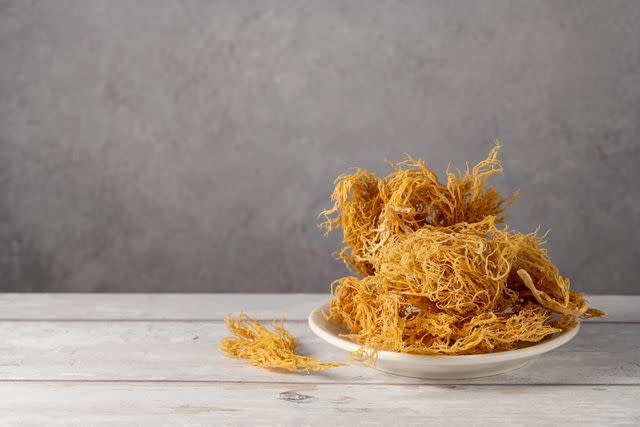
Gingagi / Getty Images
Sea moss, also known as Irish moss, is a type of red algae that grows along the rocky parts of the Atlantic coast of Europe and North America. This sea vegetable is known for its gelatinous consistency and contains many nutrients, including iodine, potassium, calcium, and vitamins A, D, E, and K.
Traditionally, sea moss has been used in food and medicine, particularly in Ireland, where it was a source of sustenance during the potato famine in the 19th century. In recent years, sea moss has gained popularity as a superfood, touted for its potential health benefits and versatility.
The health benefits of consuming sea moss might be wide-ranging, although more data is needed to confirm these potential links. It is thought to support thyroid function due to its iodine content, improve immune health thanks to the vitamin C it contains, and aid digestion thanks to the fiber content.
Some claim that sea moss can support skin health—due, in part, to the natural sulfur it provides. One 2022 study showed that sulfur intake might reduce visual signs of skin aging.
You can make a spirulina gel by soaking and blending the dried form with water. This gel can then be added to smoothies, teas, soups, and even desserts as a nutrient booster. However, like with any supplement, consult with a healthcare provider before adding sea moss to your diet, especially for those with certain health conditions (like a thyroid disorder) or those taking specific medications.
3. Nori
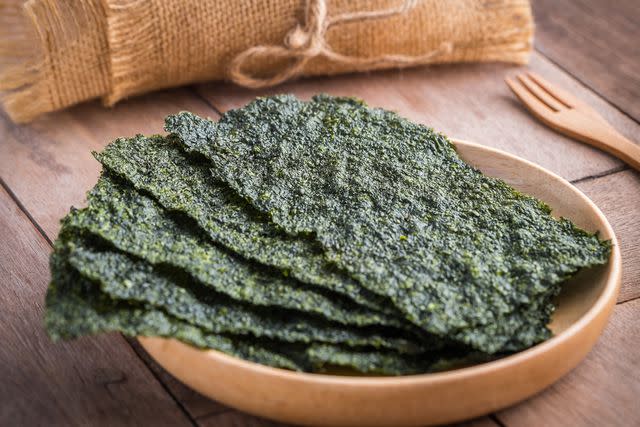
Amarita / Getty Images
Nori is a type of edible seaweed often used in Japanese cuisine, most notably as a wrap for sushi rolls. This sea vegetable is dark green to black and is sold in thin, dried sheets. Nori is harvested from the ocean, washed, chopped, pressed into sheets, and dried. It's recognized not only for its essential role in culinary practices around the world but also for its nutritional value, offering a natural source of vitamins and minerals.
Including nori in your diet can bring various health benefits, as it is a source of vitamins A, C, and E, along with essential minerals like iodine, which is vital for proper thyroid function. Nori is a source of protein and fiber, helping to promote satiety and aid digestion. It might also be linked to reduced blood pressure.
You can incorporate nori into your diet by preparing traditional sushi rolls, adding shredded nori to soups and salads for a nutritious boost, or simply snacking on roasted nori sheets.
4. Wakame
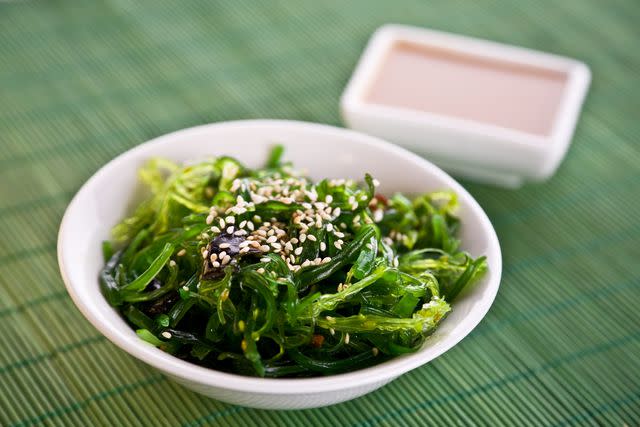
supermimicry / Getty Images
Wakame is a staple in Japanese cuisine but has gained popularity worldwide for its health benefits. It's a dark, leafy green sea vegetable that grows in the cool waters off the coasts of Japan, Korea, and China.
Known scientifically as Undaria pinnatifida, wakame is a source of essential nutrients, including iodine, calcium, magnesium, iron, vitamins A, C, E, and K, and a range of antioxidants. These components maintain thyroid function, improve bone health, boost immune function, and reduce the risk of chronic diseases. Wakame's unique compound, fucoxanthin, has been studied for its ability to aid in fat metabolism, making wakame an attractive addition to weight management strategies.
One common way to enjoy wakame is in miso soup. It can also be used fresh in salads, where its slightly sweet, yet salty flavor complements a wide range of vegetables and dressings. To prepare, simply soak dried wakame in water for about 5-10 minutes until it becomes soft, then squeeze out excess water and add it to your dish. Try incorporating it into stir-fries, rice dishes, or as a side, seasoned with sesame oil and soy sauce.
5. Chlorella
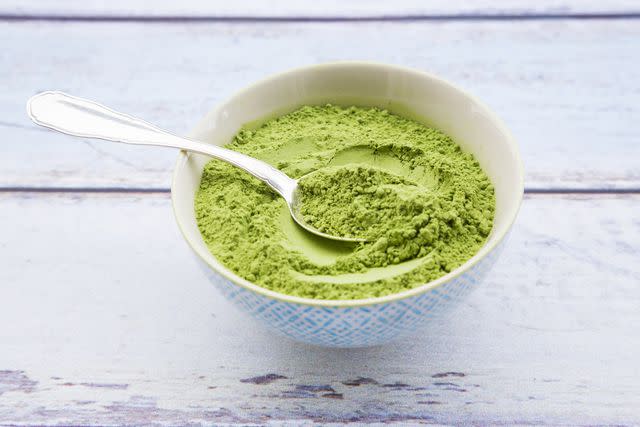
Westend61 / Getty Images
Chlorella algae is a single-celled freshwater algae known for its incredible nutritional density and health benefits. It's a source of proteins, vitamins (especially vitamin B12), minerals, and antioxidants.
What sets chlorella apart is its high chlorophyll content, which is thought to “cleanse” the body by binding to toxins and promoting their elimination. It also boasts a unique component called chlorella growth factor, which is believed to support tissue repair and immune system function.
Incorporating chlorella into your diet can be simple and versatile. Available in tablet, powder, or capsule form, it can easily be added to your daily regimen. For those who prefer its natural form, chlorella powder can be blended into smoothies, juices, or salad dressings for an added nutritional boost.
What To Look For
Finding a quality algae product requires careful consideration of several factors to ensure its purity, nutritional value, and safety. When shopping for algae supplements or products in a store or online, start by examining the label for the source of the algae. Look for products that specify their algae as being cultivated in controlled environments, free from contaminants, rather than harvested from the wild, which can result in a higher risk of contamination.
Additionally, when it is an option, opt for choices that are third-party verified, especially if you are choosing algae in supplement form (like a powder). This ensures that the product meets stringent quality standards. The label should also disclose the specific type of algae (e.g., spirulina, chlorella) and its form (powder, tablets, capsules). Opt for products that list a high concentration of the active ingredient without a long list of fillers or additives.
Lastly, consider the brand's reputation and reviews. Brands that are transparent about their sourcing, manufacturing processes, and quality testing are more likely to offer a product you can trust.
Tips For Consuming Algae
To incorporate algae into a balanced diet, consider the following tips along with snack or meal ideas:
Smoothie booster: Add a teaspoon (tsp) of spirulina or chlorella powder to your morning smoothie. These algae varieties are packed with protein and a range of vitamins and minerals, offering a nutritious start to your day. Combine with fruits such as bananas and mangoes for a sweet, energizing drink.
Salad topping: Sprinkle dried seaweed flakes over your salad to introduce a crunchy texture and a salty flavor. This not only enhances the taste but also increases your iodine intake, which is crucial for thyroid health.
Sushi makeover: For a homemade sushi night, use sheets of nori as the wrap for your rolls. Fill them with rice, vegetables, and your choice of protein for a balanced meal that naturally integrates the health benefits of algae.
Snack on the go: Keep a package of roasted seaweed snacks in your bag for a quick, healthy option when you're on the move. These are low in calories but high in vitamins and minerals, making them an ideal snack.
Incorporating algae into your meals and snacks can be an easy and tasty way to boost your nutrient intake and enjoy the health benefits of these powerful marine plants.
A Quick Review
Including algae in your diet can enhance your health and nutritional intake. As a natural source of essential nutrients like protein, vitamins, and minerals, algae offer a sustainable and versatile food source that may support many aspects of our health.
Integrating algae into your diet not only benefits individual health but also serves as a step towards a more sustainable and environmentally friendly food ecosystem. With its myriad health benefits and low environmental impact, algae stands out as a superfood worthy of incorporation into the modern diet.
For more Health.com news, make sure to sign up for our newsletter!
Read the original article on Health.com.

